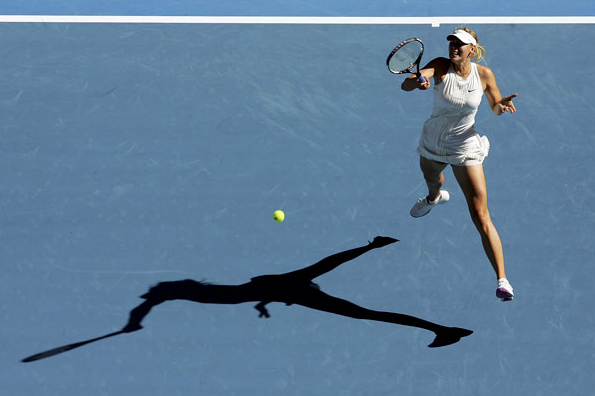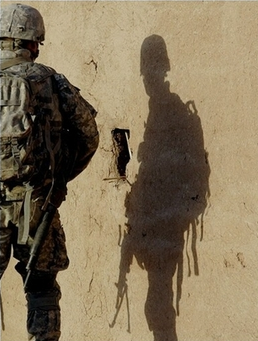Every so often there will be a soft news photo that features the optical effect of a double image. It might involve a mirror or TV monitor or a photograph, among other options. Shadows are another variant of optical replication, as in this photo from the Australian Open:
Maria Sharapova is hitting a forehand. It’s not a good photo of her. At the least, most photo editors would have no interest in a long view that has her looking awkward and disconnected from her own shot much less the flow of the game. (Unless, perhaps, she was blundering to a loss, but she won the match handily.) One thinks of antique images from the 1920s, when the game had style but none of the extreme athleticism that we now take for granted.
But it’s not a picture about her, directly. The interest is created entirely by the shadow. The optical doubling of Sharapova lies along the two primary axes of the composition: she defines the vertical plane, while her shadow lies along the horizontal. Sharapova is the familiar presence visually, but the shadow is reinforced by the horizontal white line crossing the field of blue along the top of the photograph. The ball lies like a point in a graph, the intersection of X and Y coordinates. Thus, the figural composition acquires a hue of abstraction. This is not a photograph of a person, but of something else.
What else? The shadow knows. We can look there for the form of a thing and so for what we might miss when distracted by all the details of ordinary perception oriented toward social interaction. Were we looking only at Sharapova swinging her racket, we should see an individual tennis player, someone with a specific face, look, game. When we look at the shadow, however, the distortion created by the angle of the light and twist of her body brings something more elemental to the surface of the court. There we see a body transformed by the act of hitting the ball. The shadow outline of her legs is much like her legs, but as she torques through the shot her torso appears to be compressed into one continuous limb that grows out of her pelvis and arcs into forearm, hand, and racket. Her head has disappeared into upper body which has morphed to maximize the force traveling into the prosthetic extension of the hand. What started out human ends up a hitting machine.
Thus, the optical double reveals a more abstract dimension of the act of hitting a tennis ball, and of the game of tennis as it is played on the world stage. Tennis is promoted by featuring individual players as if they were fashion models or rock stars. To get there, however, the players need a lot more than flair. They can only succeed by subjecting themselves to grueling training that makes them extremely efficient competitors, and little else.
Shadows can reveal the other self. Like the portrait of Dorian Gray, the double might reveal one’s sins, but that might be more melodramatic than is needed much of the time. A shadow also could lend itself to recollection or prophecy or other opportunities for reflection. I’ll close with another image, one also taken because of the shadow in the frame.
This image of an American soldier in Iraq is a study in opposites. The soldier, who should be the focal subject, is partially outside the frame and has his back to us. His shadow, which should be merely an afterimage, is in the right center of the picture and facing forward. Indeed, the shadow figure seems almost exposed, turned toward us in a way that makes him seem vulnerable, open to injury as the stalwart soldier shielded by his backpack is not. That vulnerability is accentuated by the distortion, which makes him appear slouched, even sunken-chested. And this shadow is not hard dark but rather a soft, yellowish color like the wall behind it. This double is wraith-like, a ghostly presence with streamers and gun drooping down like Marley’s chains, though ethereal. And also, like the photograph above, somehow less than human: in this case, arachnoid–like a spider or scorpion lying in wait in the sun.
Somewhere between Sad Sack and the war dead while looking like a primitive predator, this shadow could be the image of the elemental soldier. That is, the soldier seen without the martial virtues evident in the actual figure on the left. The soldier who, for all his terrible power, will not project power for long, whose presence will evaporate in time even if he is not killed first. The soldier who will have to be replaced by another much like him.
Photographs by Ezra Shaw/Getty Images (1/14/08) and Alexander Nemenov/AFP (9/29/07).


Dr. Bob: The Sharapova shadow is stunningly resonant with another sports icon:
http://www.solepedia.com/Air_Jordan
Steve: Nice connection. Might be another instance of unconscious replication of an iconic template.
Yes, I was also struck by the parallel with the Air jordan image. It suggests to me that these shadow-images are iconic in a particular way. Their existence-as-absence makes the image universalized, idealized, disembocied and therefore available to haunt the social imagination.
I find Sharapova as a person (that is, as a persona) singularly unappealing. Fake, spoiled, “beautiful” in an artificial and conventional sort of way. But the shadow is compelling.
Similarly, featuring the olive-drab shadow of the soldier rather than his specific attributes or location connects the image not to this war, but to soldiers as a type and all the social mythology that goes along with it. Closer to WWII than to Vietnam, more the faceless citizen-soldier of Iwo Jima than the high-tech fighting machine of the modern military.
I have been thinking about images of shadows.
The Australian Open logo has a similar form of shadow-in-motion. It seems to me that this might have to do with energy. The athletic shadow becomes displaced from the limits of the individual into a pure athletic form without flaw or fatigue. Similarly, there is a sense in which the soldier’s shadow is pure fatigue (a socially significant pun?).
The images of sport and combat are intricately connected as well (think of Huizinga in _Homo Ludens_). The athlete-shadow moves joyfully, driven by a perfect completeness of energy; conversely, the soldier-shadow moves onward despite the almost-perfect lack of energy. Both are images of movement, both focused on the moment, not on the end of action–which may or may not be realized, which may or may not be clearly understood.
There is another connection as well–both are images of admiration. The viewer is called to admire the physical vitality of the athlete-shadow and, in a different sense, to admire the dogged perseverance of the soldier-shadow. The shadow, the person-that-is-not-a-person, moves with the grace of flight or dance because of the almost-pure energy in the Sharapova/Jordan images. In the soldier image, the shadow moves with an almost-pure gracelessness despite its almost-total lack of energy. The viewer’s admiration depends only on action in the face of limits, and not on either person or purpose.
http://politicstheoryphotography.blogspot.com/2008/01/shadows.html
Hey Bob, I like thi sspost; it prompted me to dig out one of the most powerful images I know and write a post of my own. Hope you are well!